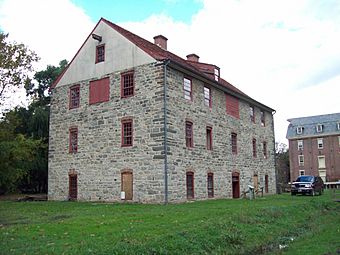The Tannery (Bethlehem, Pennsylvania) facts for kids
Quick facts for kids |
|
|
The Tannery
|
|

The Tannery, October 2011
|
|
| Location | Within Bethlehem Historic Subdistrict A near Monocacy Creek, Bethlehem, Pennsylvania |
|---|---|
| Area | 3 acres (1.2 ha) |
| Built | 1761 |
| NRHP reference No. | 72001143 |
| Added to NRHP | June 19, 1972 |
The Tannery is a very old building in Bethlehem, Pennsylvania. It was built in 1761 by a group called the Moravians. This building is made of limestone. It is part of an area known as the Bethlehem Colonial Industrial Quarter.
The Tannery was added to the National Register of Historic Places in 1972. This means it is an important historical site. It is also part of the Historic Moravian Bethlehem District. This district became a National Historic Landmark in 2012. It might even become a World Heritage Site one day!
Contents
What is The Tannery?
The first tannery was a small log building. It was built in 1743. It stood near the Grist Mill, which is now Luckenbach Mill. Leather was very important back then. It was used for many things and was worth a lot of money. This made the tannery a very busy and important place.
It made leather for shoemakers and people who made harnesses. These items were needed in Bethlehem and nearby towns. As the community grew, the tannery needed to be bigger. So, a new stone building was built in 1761. This is the Tannery building we see today.
How the Tannery Grew
The new building was made of stone. It was built in a German Colonial style. It had three stories and a small attic. By the 1760s, the Moravians were very busy. They processed 1,000 to 2,000 animal hides each year. They made many leather products. These included clothes, shoes, and parts for machines.
The Tannery was one of their most profitable businesses. When the American Revolutionary War started, trade with England stopped. This made leather even more important. The Continental Army needed lots of leather. They needed boots, caps, coats, and saddles. The Tannery then processed about 3,000 animal hides every year!
Later Years and Restoration
The Moravians ran the Tannery until 1829. Making leather stopped there in 1873. This was because the price of tanbark became too high. The building was then used as homes for families. Over time, it became very run down. It was even surrounded by an old car junk yard.
From 1968 to 1971, the Tannery was restored. Experts worked to make it look like it did in the 1700s. After this, the building opened to the public. People could take tours and learn about tanning. More work was done in 2001. This allowed visitors to see the vat room. However, the Tannery closed in 2004. This was due to damage from Hurricane Ivan.
Today, the city of Bethlehem owns the Tannery. A group called Historic Bethlehem Museums & Sites takes care of it. The building is not open to the public right now.
How Leather Was Made
In the 1700s, turning animal hides into leather was a long process. It could take two years or even longer! The work was very hard. Wet hides could weigh hundreds of pounds.
Steps to Make Leather
Here are the main steps they used:
- First, the hides were washed, cleaned, and trimmed.
- Then, they soaked the hides in a special lime solution for weeks. This helped remove hair and extra flesh.
- Next, the hides went into a "bating" solution. This smelly mix made the leather flexible.
- After that came the main tanning step. Hides were put into vats filled with tanbark and its liquid. This soaking lasted for six to twelve months.
- Finally, the leather was beaten to make it soft. Then it was carefully dried. Some leathers needed more treatment to be smooth and waterproof.
The Importance of Tanbark
Tanbark was a key part of making leather. For each hide, they needed one to two times its weight in bark. The Tannery used a lot of tanbark each year. They used about 60 to 100 cords of bark. A cord is a large stack of wood.
Oak and hemlock barks were collected in the spring. They were dried and stored away from rain. Then, the tanbark was ground into a powder. The Moravians used a special bark stamping machine. This was different from most American mills. Those mills used animals to crush the bark with stone rollers.
Gallery




